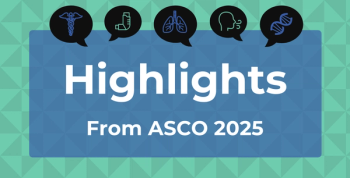
KEYNOTE-905 Paves the Way for Next Generation of MIBC Trials: Christof Vulsteke, MD, PhD
Perioperative enfortumab vedotin plus pembrolizumab demonstrated significant results in a population that represents roughly half of all patients with MIBC, explained Christof Vulsteke, MD, PhD.
Perioperative enfortumab vedotin (EV) plus pembrolizumab slashed the risk of disease progression or death by 60% in patients with muscle-invasive bladder cancer (MIBC) who are ineligible for or decline cisplatin-based chemotherapy, making the EV-303/KEYNOTE-905 trial (
In an interview with The American Journal of Managed Care® (AJMC®), principal study investigator Christof Vulsteke, MD, PhD, head of Integrated Cancer Center Ghent (IKG, Belgium) and Clinical Trial Unit Oncology Ghent, discussed the findings and how EV plus pembrolizumab fits into the growing treatment armamentarium for MIBC, particularly in the cisplatin-ineligible population.
This transcript has been edited for length and clarity.
AJMC: Could you summarize the results of the study and how EV plus pembrolizumab performed relative to surgery alone?
VULSTEKE: In this patient population that was cisplatin-ineligible—we also allowed cisplatin-declining patients at the end, but more than 80% were truly cisplatin-ineligible, mainly based on renal impairment. It was an older population; the median was 73 years old and also comprised Eastern Cooperative Oncology Group performance status 2. With this population in mind, you see that the control arm had bad outcomes and that the EV-pembrolizumab arm did much better.2 The primary end point was a strong hit for event-free survival [EFS], with an HR of 0.4 in favor of EV plus pembrolizumab. To give it in percentages, at 2 years, 39% were free of events in the control arm. In the experimental arm, that was 75%, so this is a huge difference and an early and a very sustained separation of the curves.
For the secondary end point, it was also a strong hit—patients lived longer. There was an OS hit translated into a statistically significant HR of 0.5. To put that in percentages, in the 2 years, you see 63% in the control arm and 80% in the interventional arm. And [for] the other key secondary end point of pathological complete response (pCR)—so, telling your patient after the surgery that there's not a single cancer cell left in the bladder—was 57.1%, which is the highest-ever pCR reported.
AJMC: Were the pCR, OS, and EFS rates consistent across subgroups—such as PD-L1 expression, histologic variants, or clinical stage?
VULSTEKE: Across all subgroups, there was a clear benefit with EV plus pembrolizumab, so we could not mark one in which we don't see a benefit. With EFS and for OS, there was also a consistent benefit.
AJMC: How manageable was the toxicity profile of EV when combined with pembrolizumab?
VULSTEKE: I think it was the same as in the metastatic setting. The most common toxicity was skin toxicity in the first 2 cycles especially. It’s something we know already from the metastatic setting, that there is Nectin-4 expression in the keratinocytes of the skin. If you target Nectin-4 with EV, you can imagine you can have some skin toxicities. Skin toxicity was in more than 60% of patients, but only in a minority, or around 10%, was it severe enough that it was a grade 3.
Then we have polyneuropathy—that was reported in 38% in the combined EV plus pembrolizumab group, and only a minority had severe toxicities. But just like in the metastatic setting, you need a good doctor who has experience with EV plus pembrolizumab. It's such a powerful regimen, but it's a big responsibility; the doctor needs to know about skin toxicities because they're manageable if you have the experience. And then, also for the polyneuropathy, you need a patient who tells you everything, because don't go on with this treatment if your patient develops a grade 3 toxicity. Then, you have to stop and implement drug holidays. But it was the same as in the metastatic setting, what we have seen.
AJMC: How did you manage the timing and coordination of surgery in patients receiving the perioperative regimen, and were there any surgical delays related to treatment?
VULSTEKE: That was something very important. If you give [EV plus pembrolizumab] in this population as adjuvant treatment before [surgery], would you have a delay for that surgery? But we have seen that adverse events leading to surgical delay were very low, and EV plus pembrolizumab did not at all worsen the rate of surgical complications and did not delay going to surgery.
AJMC: How do you envision this regimen fitting into the treatment algorithm for MIBC?
VULSTEKE: It is such a powerful regimen, and if available and if labeled, you should definitely use it. But I would stress that this is a cisplatin-ineligible population, so you cannot, based on this trial, immediately extrapolate this to cisplatin-eligible, which is also half of the patients [we treat]. We did recruit cisplatin-eligible patients, but it was the minority, and I think therefore we have to await the upcoming EV-304 trial [
AJMC: Is there anything else you would like to add?
VULSTEKE: I think, based on this trial, it paves the way for the next generation of trials that can also avoid procedures with a lot of comorbidities, like radical cystectomy. I think we really should go for that next chapter, that we can cure patients without removing the bladder.
References
1. Caffrey M. Enfortumab vedotin plus pembro cuts risk of disease progression, death 60% for patients with MIBC who can’t have chemo with bladder removal. AJMC. October 18, 2025. Accessed October 20, 2025.
2. Vulsteke C, Kaimakliotis H, Danchaivijitr P, et al. Perioperative (periop) enfortumab vedotin (EV) plus pembrolizumab (pembro) in participants (pts) with muscle-invasive bladder cancer (MIBC) who are cisplatin in eligible: the phase III KEYNOTE-905 study. Presented at: 50th European Society for Medical Oncology Congress; October 17-21, 2025; Berlin, Germany. Abstract LBA2.
Newsletter
Stay ahead of policy, cost, and value—subscribe to AJMC for expert insights at the intersection of clinical care and health economics.







































